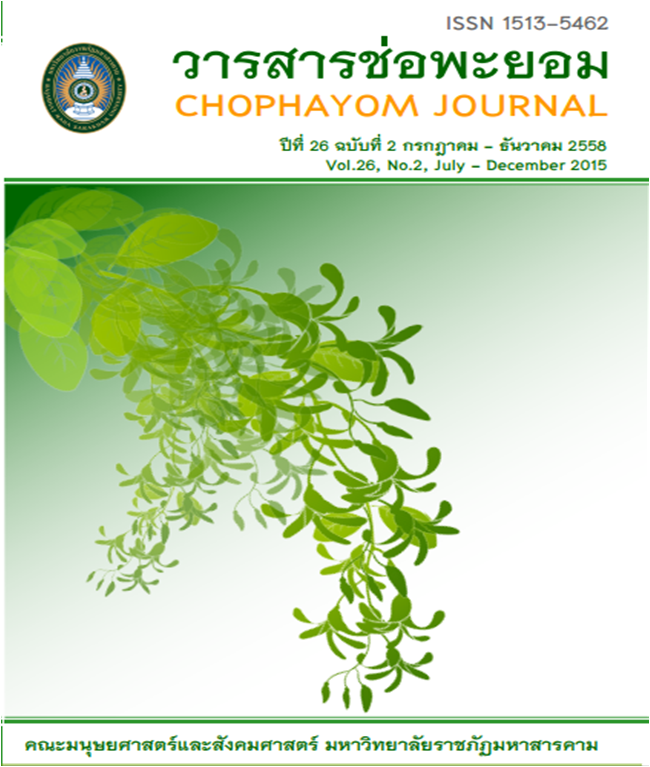การเปรียบเทียบความสามารถในการโต้แย้งและการคิดวิพากษ์วิจารณ์จากการเรียนประเด็นปัญหาสังคม ที่เกี่ยวข้องกับการใช้วิทยาศาสตร์โดยใช้รูปแบบผสมผสานตามวิธีปัญหาเป็นฐานและผสมผสาน ตามวิธีวัฏจักรการเรียนรู้ 5 ขั้น ของนักเรียนชั้นมัธยมศึกษาปีที่ 4 ที่มีความเข้าใจธรร
Abstract
บทคัดย่อ
การวิจัยครั้งนี้มีความมุ่งหมายเพื่อศึกษาและเปรียบเทียบการคิดวิพากษ์วิจารณ์และความสามารถในการโต้แย้งจากการเรียนประเด็นปัญหาสังคมที่เกี่ยวข้องกับการใช้วิทยาศาสตร์ โดยใช้รูปแบบผสมผสานตามวิธีปัญหาเป็นฐานและวิธีวัฏจักรการเรียนรู้ 5 ขั้น ของนักเรียนชั้นมัธยมศึกษาปีที่ 4 จำนวน 96 คน โดยรวมและจำแนกตามความเข้าใจธรรมชาติวิทยาศาสตร์ที่ได้มาโดยการสุ่มแบบกลุ่ม ได้แก่ กลุ่มทดลองที่ 1 จำนวน 48 คน เรียนแบบผสมผสานตามวิธีปัญหาเป็นฐาน และกลุ่มทดลองที่ 2 จำนวน 48 คน เรียนแบบผสมผสานตามวิธีวัฏจักรการเรียนรู้ 5 ขั้น เครื่องมือที่ใช้ในการเก็บรวบรวมข้อมูล ได้แก่ 1) แผนการจัดการเรียนรู้โดยใช้ประเด็นปัญหาทางสังคมที่เกี่ยวข้องกับการใช้วิทยาศาสตร์ 3 เรื่อง ได้แก่ การค้ามนุษย์เพื่ออุ้มบุญการุณยฆาตการโคลนนิ่ง สำหรับการเรียนแบบผสมผสานตามวิธีปัญหาเป็นฐาน และวิธีวัฏจักรการเรียนรู้ 5 ขั้นอย่างละ 3 แผน ใช้เวลาเรียนแผนละ 3 ชั่วโมงต่อสัปดาห์ 2) แบบทดสอบวัดความสามารถในการโต้แย้ง 4 ฉบับ ๆ ละ 4 ข้อ 3) แบบ ทดสอบวัดการคิดวิพากษ์วิจารณ์จำนวน 40 ข้อมี 4 ด้าน คือ ด้านการพิจารณาความน่าเชื่อถือของแหล่งข้อมูล และการสังเกต ด้านการนิรนัย ด้านการอุปนัย และด้านการระบุข้อตกลงเบื้องต้นสถิติที่ใช้ในการทดสอบสมมติฐาน ได้แก่ Paired t-test และ F-test (Two-way MANCOVA และ ANCOVA)
ผลการวิจัยพบว่า นักเรียนโดยส่วนรวมและจำแนกตามความเข้าใจธรรมชาติวิทยาศาสตร์หลังเรียนประเด็นปัญหาทางสังคมที่เกี่ยวข้องกับการใช้วิทยาศาสตร์โดยใช้รูปแบบผสมผสานตามวิธีปัญหาเป็นฐานและวิธีวัฏจักรการเรียนรู้ 5 ขั้น มีการพัฒนาความสามารถในการโต้แย้งเพิ่มขึ้นจากการทดสอบประเด็นที่ 1-4 และมีการคิดวิพากษ์วิจารณ์โดยรวมและรายด้านเพิ่มขึ้นจากก่อนเรียน (p<.001) นักเรียนที่มีความเข้าใจธรรมชาติวิทยาศาสตร์สูงที่มีเฉพาะการคิดวิพากษ์วิจารณ์เป็นรายด้านจำนวน 3 ด้าน ยกเว้นด้านนิรนัยมากกว่านักเรียนมีความเข้าใจธรรมชาติวิทยาศาสตร์ต่ำ (p≤.020) ส่วนนักเรียนที่เรียนโดยใช้รูปแบบผสมผสานตามวิธีปัญหาเป็นฐานมีความสามารถในการโต้แย้งและการคิดวิพากษ์วิจารณ์โดยรวมและรายด้านจำนวน 2 ด้าน คือ ด้านการอุปนัยและด้านการระบุข้อตกลงเบื้องต้นมากกว่านักเรียนที่ใช้รูปแบบผสมผสานตามวิธีวัฏจักรการเรียนรู้ 5 ขั้น (p=.007) นอกจากนี้มีปฏิสัมพันธ์ระหว่างความเข้าใจธรรมชาติวิทยาศาสตร์กับรูปแบบการเรียนเฉพาะความสามารถในการคิดวิพากษ์วิจารณ์ด้านการอุปนัยและด้านการระบุข้อตกลงเบื้องต้น (p≤.040)
คำสำคัญ : ประเด็นปัญหาทางสังคมที่เกี่ยวข้องกับการใช้วิทยาศาสตร์, การโต้แย้ง, การคิด
วิพากษ์วิจารณ์, การเรียนแบบผสมผสาน
ABSTRACT
This research aimed to study and compare theargumentation and criticalthinkingabilities after learning the socioscientific issues byusing the mixed methods based on the problem-based learning method andthe 5E - learning cycle approach of ninety-six Mathayomsuksa 4 students as a whole and as classified according to understandings of the nature of science.They wereselected using the cluster random sampling technique and were divided into 2 groups : theexperimental groupone of 48 students learned using the mixed methods based on theproblem-based learning methodand the experimental grouptwoof 48 students learned the mixed methods based on the 5E - learning cycleapproach. Research instruments included :(1) learning plans on 3 socioscientific issues:Human Trafficking for Surrogacy, Euthanasia,and Cloning,for themixed methods based on the problem-based learning method andthe mixed methods based on the 5E - learning cycle approach, 3 plansand each plan for 3 hours of learning in a week ; (2) four argumentation tests, 4 itemseach; and (3) a critical thinking abilities test with 4 subscales and 40 items :credibility of sources and observation,deduction,induction and assumptionidentification.The collected data were analyzed for testing hypotheses by using thepaired t – test and the F – test (Two – way MANCOVA and ANCOVA).
The research findings revealed that the students as a whole and as classified according
to understandings of the nature of science who learned the socioscientific issues usingthe mixed methods based on the problem-based learning method andthe 5E - learning cycle approachshowed developments of argumentation from the 1stto 4thtest ; and showed gains in an entire critical thinking and in each of 4 subscales from before learning (p < .001).The highscience understanding students indicated only more critical thinking in 3 subscales.except for the deduction subscale.than did the low science understanding students (p ≤ .020).The experimental groupone studentsevidenced more argumentation and critical thinking abilities in general and in 2subscales :induction and assumption identification,than the experimental grouptwostudents(p=.007).In addition, there were statistical interactions of understandings of the nature of science with learning methodonly on 2 subscales of criticalthinkingabilities: induction and assumption identification (p≤.040).
Keywords : SocioscientificIssues Using, Argumentation, Critical Thinking, Mixed Methods





